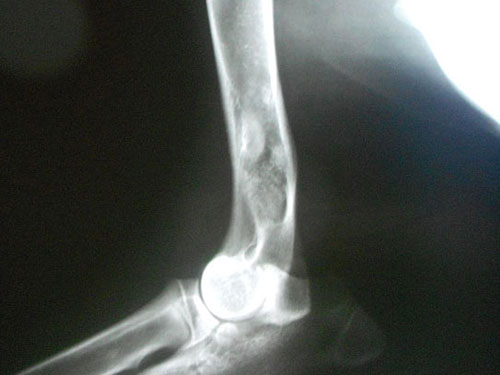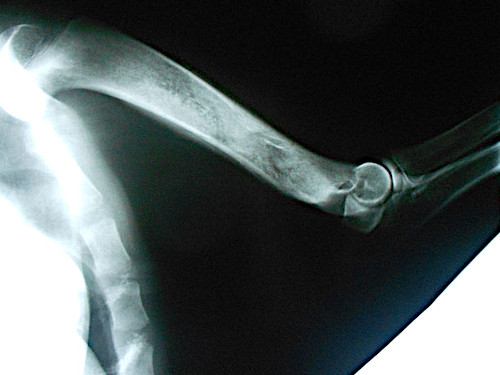 A 6-month-old German Shepherd was presented because of limping. During the exam, Dr. Neumeister found that the dog was very uncomfortable with the extension of the left front leg and was able to extend it only 30%.
A 6-month-old German Shepherd was presented because of limping. During the exam, Dr. Neumeister found that the dog was very uncomfortable with the extension of the left front leg and was able to extend it only 30%.
No fever was present. Radiographs of the front legs were scheduled to rule out osteochondrosis, osteosarcoma (bone cancer), fracture, or soft tissue tears.
Radiographs of both shoulders showed intramedullary osseous lesions in both humeri. The scapulohumeral joint was clean.
Bone is made of an outer cortex and an inner medulla. The difference in density allows for differentiation on X-rays – the cortex being denser and therefore whiter. Note that the cortex of the long bones was free of lesions. The increased densities were found medulla or interior of the of the long bone shaft.
 Panosteitis was diagnosed. This condition frequently occurs in German shepherds and German shepherd mixes between 5 and 18 months of age. Other breeds that are medium to large may be affected as well. The dog usually presents with lameness in a front leg although it may be shifting leg lameness.
Panosteitis was diagnosed. This condition frequently occurs in German shepherds and German shepherd mixes between 5 and 18 months of age. Other breeds that are medium to large may be affected as well. The dog usually presents with lameness in a front leg although it may be shifting leg lameness.
They may be depressed, have decreased appetite, and have a mild fever. Pain may be elicited when pressing on the shaft of the bone. Muscle atrophy may occur.
The condition is often self-limiting by 2 years of age. However, the discomfort often requires analgesics and antiinflammatories until that time.
Definitions:
- Humerus (pl.= humeri): bone of the upper foreleg of a dog
- Lesion: any abnormality in the tissue of an organism (in layman’s terms, “damage”), usually caused by disease or trauma.
- Osseous: having to do with bone, consisting of bone, or resembling bone.
- Intramedullary: the marrow cavity of a bone
- Scapulohumeral: shoulder
